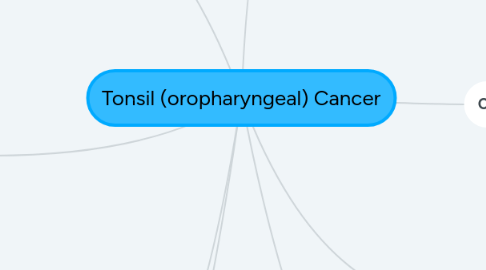Tonsil (oropharyngeal) Cancer
by Krista Hamlin


1. Diagnostic Tests
1.1. physical exam of mouth/throat/neck/tonsils and surrounding tissues
1.2. MRI
1.3. CT
1.4. PET scan
1.5. blood tests
1.6. biopsy/fine needle aspiration
2. Symptoms
2.1. swollen tonsils
2.2. mouth pain
2.3. sores in mouth/throat that do not heal
2.4. earaches
2.5. difficulty or pain with swallowing
2.6. lumps in neck/neck pain
2.7. sore throat
2.8. blood-tinged saliva
2.9. bad breath
3. Treatments
3.1. surgery
3.1.1. transoral surgery with or without robotic arm
3.1.1.1. open surgery if cancer tumors are large
3.2. chemotherapy
3.3. radiation
3.3.1. IMRT (intensity-modulated radiation therapy
3.3.1.1. proton therapy
3.4. gastrotomy tube
3.5. implanted chest port
3.6. cancer staging will effect/determine type and course of treatment combinations.
3.7. HPV vaccines
4. Tonsils
4.1. 3 kinds of tonsils: pharyngeal, palatine, lingual tonsils
4.1.1. palatine are most likely to become malignant (cancerous)
5. Pathophysiologic etiology
5.1. squamous cell carcinoma
5.1.1. cancer of the epithelial tissue
5.1.1.1. aggressive cancer cells that can grow large and spread to other areas in the body.
5.2. lymphoma
5.2.1. cancer of lymph cells that line tonsils
6. Causitive/Risk factors
6.1. smoking
6.2. drinking alcohol
6.3. HPV (human papillomavirus)
6.3.1. 70% of all oropharyngeal cancers can be linked to HPV
6.4. 50 years old or older
6.5. male
7. Rehabilitation
7.1. swallow/speech therapists
7.2. physical therapy
7.3. occupational therapy
7.4. dietician consultation
7.5. physcologists
8. Immunity
8.1. tonsils are part of body's immunity and function as a defense mechanism.
8.1.1. tonsils fight infection
8.1.2. when germs enter mouth tonsils activate immune response.

